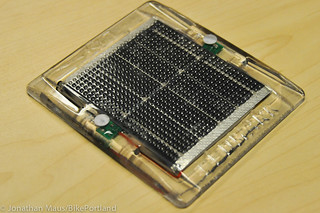The Portland Bureau of Transportation will install the city’s first illuminated bike lane markers next week (sorry, it’s not the glow-in-the-dark “starpath” everyone’s talking about). According to PBOT Active Transportation Division Manager Dan Bower, on Tuesday crews will install 20 solar-powered LED lights in the bike lane stripe on NE Couch as it makes the s-curve onto the Burnside Bridge (a somewhat notorious location if you recall).
The lights, which are only 7 millimeters tall, will be installed flush with the ground about every 15 feet (see below). They’ll turn on automatically as the sun sets. Bower told us he first saw them in use in Denmark (where they’re made) and thought they could be helpful safety and wayfinding devices here in Portland. Saris Racks is importing the lights from Denmark (apparently the company wants to get into the U.S. bikeway building boom) and they have donated the lights to PBOT for this pilot project. The price of each light, including the epoxy to secure them into the ground, is $140.

the existing strip/buffer area.
(Graphic: BikePortland)
Bower said PBOT has purposefully timed the installation of the new lights to coincide with the end of Daylight Saving Time. While the lights will help with the safety issue of people driving into bike lanes (especially on curvy roads), Bower said, they are not meant as as substitute for physically separated lanes. “These lights don’t replace better design,” he said, “I’d rather have a curb, but I don’t have the money for a curb.”
Since the lights will be installed flush with the pavement, there shouldn’t be any noticeable bumps to drivers or riders. And, although the solar panels and LEDs are encased in a plastic shell, the surface is textured so slippage should not be an issue. According to Saris, the lights can be seen from 1000 meters away and have a battery life of 5-10 years.
There are several different colors available, but PBOT’s first run will be white. Here’s how it looks lit up…

Bower said PBOT will look to expand the use of these lights if the pilot program is successful. Another area he mentioned that might benefit from these is the southwest corner of SW Broadway and 6th — a bike lane that is frequently encroached on by drivers.
A Saris product fact sheet (PDF) shows several implementation examples…

Along with helping provide a visual cue for the presence of a bike lane, another common use of these lights is to help illuminate paths like the Springwater Corridor at night.
For what it’s worth, Portland is the first U.S. city one of the first U.S. cities to test these lights in a real-life, urban conditions. Saris hopes the Portland launch will provide them with useful product feedback and help garner additional customers in other cities.
Stay tuned next Tuesday for a follow up post once these are installed.


